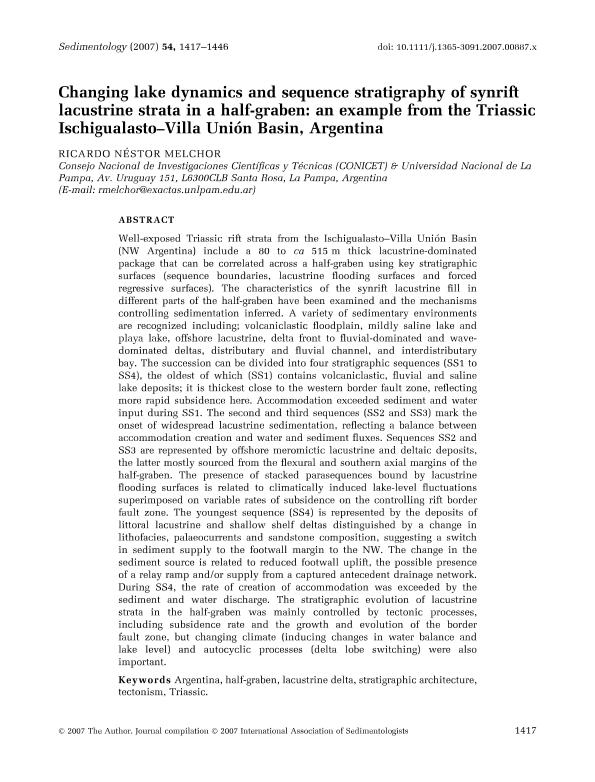Mostrar el registro sencillo del ítem
dc.contributor.author
Melchor, Ricardo Nestor

dc.date.available
2019-08-16T13:53:45Z
dc.date.issued
2007-12
dc.identifier.citation
Melchor, Ricardo Nestor; Changing lake dynamics and sequence stratigraphy of synrift lacustrine strata in a half-graben: An example from the Triassic Ischigualasto-Villa Unión Basin, Argentina; Wiley Blackwell Publishing, Inc; Sedimentology; 54; 6; 12-2007; 1417-1446
dc.identifier.issn
0037-0746
dc.identifier.uri
http://hdl.handle.net/11336/81702
dc.description.abstract
Well-exposed Triassic rift strata from the Ischigualasto-Villa Unión Basin (NW Argentina) include a 80 to ca 515 m thick lacustrine-dominated package that can be correlated across a half-graben using key stratigraphic surfaces (sequence boundaries, lacustrine flooding surfaces and forced regressive surfaces). The characteristics of the synrift lacustrine fill in different parts of the half-graben have been examined and the mechanisms controlling sedimentation inferred. A variety of sedimentary environments are recognized including; volcaniclastic floodplain, mildly saline lake and playa lake, offshore lacustrine, delta front to fluvial-dominated and wave-dominated deltas, distributary and fluvial channel, and interdistributary bay. The succession can be divided into four stratigraphic sequences (SS1 to SS4), the oldest of which (SS1) contains volcaniclastic, fluvial and saline lake deposits; it is thickest close to the western border fault zone, reflecting more rapid subsidence here. Accommodation exceeded sediment and water input during SS1. The second and third sequences (SS2 and SS3) mark the onset of widespread lacustrine sedimentation, reflecting a balance between accommodation creation and water and sediment fluxes. Sequences SS2 and SS3 are represented by offshore meromictic lacustrine and deltaic deposits, the latter mostly sourced from the flexural and southern axial margins of the half-graben. The presence of stacked parasequences bound by lacustrine flooding surfaces is related to climatically induced lake-level fluctuations superimposed on variable rates of subsidence on the controlling rift border fault zone. The youngest sequence (SS4) is represented by the deposits of littoral lacustrine and shallow shelf deltas distinguished by a change in lithofacies, palaeocurrents and sandstone composition, suggesting a switch in sediment supply to the footwall margin to the NW. The change in the sediment source is related to reduced footwall uplift, the possible presence of a relay ramp and/or supply from a captured antecedent drainage network. During SS4, the rate of creation of accommodation was exceeded by the sediment and water discharge. The stratigraphic evolution of lacustrine strata in the half-graben was mainly controlled by tectonic processes, including subsidence rate and the growth and evolution of the border fault zone, but changing climate (inducing changes in water balance and lake level) and autocyclic processes (delta lobe switching) were also important.
dc.format
application/pdf
dc.language.iso
eng
dc.publisher
Wiley Blackwell Publishing, Inc

dc.rights
info:eu-repo/semantics/openAccess
dc.rights.uri
https://creativecommons.org/licenses/by-nc-sa/2.5/ar/
dc.subject
Argentina
dc.subject
Half-Graben
dc.subject
Lacustrine Delta
dc.subject
Stratigraphic Architecture
dc.subject
Tectonism
dc.subject
Triassic
dc.subject.classification
Geología

dc.subject.classification
Ciencias de la Tierra y relacionadas con el Medio Ambiente

dc.subject.classification
CIENCIAS NATURALES Y EXACTAS

dc.title
Changing lake dynamics and sequence stratigraphy of synrift lacustrine strata in a half-graben: An example from the Triassic Ischigualasto-Villa Unión Basin, Argentina
dc.type
info:eu-repo/semantics/article
dc.type
info:ar-repo/semantics/artículo
dc.type
info:eu-repo/semantics/publishedVersion
dc.date.updated
2019-08-15T16:04:58Z
dc.journal.volume
54
dc.journal.number
6
dc.journal.pagination
1417-1446
dc.journal.pais
Reino Unido

dc.journal.ciudad
Londres
dc.description.fil
Fil: Melchor, Ricardo Nestor. Consejo Nacional de Investigaciones Científicas y Técnicas. Instituto de Ciencias de la Tierra y Ambientales de La Pampa. Universidad Nacional de La Pampa. Facultad de Ciencias Exactas y Naturales. Instituto de Ciencias de la Tierra y Ambientales de La Pampa; Argentina
dc.journal.title
Sedimentology

dc.relation.alternativeid
info:eu-repo/semantics/altIdentifier/url/https://onlinelibrary.wiley.com/doi/abs/10.1111/j.1365-3091.2007.00887.x
dc.relation.alternativeid
info:eu-repo/semantics/altIdentifier/doi/https://doi.org/10.1111/j.1365-3091.2007.00887.x
Archivos asociados
